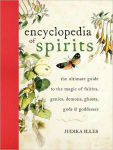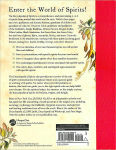Read an Excerpt
Encyclopedia of Spirits
The Ultimate Guide to the Magic of Fairies, Genies, Demons, Ghosts, Gods & Goddesses
By Judika Illes HarperCollins Publishers, Inc. Copyright © 2009 Judika Illes
All right reserved. ISBN: 9780061350245
Chapter One
Elements of Working with Spirits: A Spirit Worker's Glossary
Working with spirits possesses its own specialized vocabulary. Let's explore and define some of the most commonly used terms and words frequently appearing throughout this book. Not all terms and concepts apply to all spiritual traditions. Some terms are straightforward and easy to understand. Others involve extremely esoteric concepts. Some information is suitable for beginners. Other elements are advanced. If something fails to make sense now, don't worry. Understanding may accompany further experience.
Altar
The term derives from the Latin altare, meaning "a high place" (high altitudes were a preferred location for the earliest altars). In its most general sense, an altar is a space dedicated to the veneration of someone or something. The very first altars were spiritual, but in the modern secular world, altars are also constructed to honor pop or sports stars (whether consciously intended as altars or not). Describing a teenager's room as a shrine to a pop idol accurately describes the finished effect.
Altars may be dedicated to any spirit. The concept transcends religious and spiritual boundaries.Altars may be public or private, personal or part of an organized religious institution. Churches, cathedrals, and temples of many faiths often contain individual altars dedicated to specific saints or spirits. Although some spirits are closely identified with specific sites and/or shrines, most are subjects of home altars, too.
Altars are tableaux or arrangements of specific articles. Everything involved in the creation of an altar is carefully chosen. Nothing on an altar is random. Altars may be color-coordinated to suit a spirit. Candles, incense, fragrance, flowers, gifts, food, and drink are offered to a spirit on an altar, in the process becoming part of the altar.
An altar may serve as an individual's tribute to one or more spirits or operate as the equivalent of a visual journal or log of an individual's spiritual path. Spirits, their images, and/or power objects are added, moved, and removed as inspired.
Although it is common to include images of spirits on altars, this is unnecessary. Those who object to graven images may create altars with only candles, flowers, or neutral objects. An altar reflects the spirit it venerates and the needs of the devotee.
Altars come in many styles and sizes. The simplest Spiritualist altars consist of a candle and a glass of water, considered the basic components of spirit summoning, while lavish, complex Vodoun altars are entire rooms filled with lovingly, meticulously arranged treasures. Tiny miniature altars are contained in matchboxes, shadowboxes, or cigar boxes.
Altars may be permanent or temporary. Some rituals or magic spells involve creating a temporary altar. Those making specific but presumably one-time requests of a spirit may wish to set up such a temporary altar: a tableau that exists only for the duration of the ritual or spell or until the request has been fulfilled.
Permanent altars keep the presence and image of the spirit close. Erika Doss' essay, "Saint Elvis" (contained in the 1999 book, Elvis Culture), describes shrines constructed for Elvis Presley within the homes of fans and devotees that become entrenched into the décor of the home itself.
The following people may prefer permanent tableaux:
- Those who have developed close working relationships with spirits
- Those seeking to develop such a relationship
- Those who simply adore a spirit
Constructing permanent home altars for some spirits is discouraged, especially those spirits intimately associated with illness. Disease spirits transmit and remove illness. Appeals are typically directed toward them when healing is desired. Once that is achieved, it is usually considered best not to maintain the spirit's interest for longer than necessary. You don't want them to feel too comfortable in your home.
Altars have a tendency to take on a life of their own. They are not static, but evolve over time with items continually added and (less frequently) removed. A person may maintain one altar for one spirit, or one altar may honor many spirits. Several distinct altars may be simultaneously maintained for different spirits, one spirit per altar. It all depends on the spirits in question and your own spiritual path and needs.
Many, although not all, spirits are gregarious: willing and happy to share space with each other. Exceptions are noted in entries for individual spirits, but a good rule of thumb is that if bitter conflict between two spirits is an integral part of their mythology, it may be best to keep some space between them.
What is the purpose of an altar?
Altars summon spiritual assistance. The components of the altar serve as signals to spirits that their presence is desired. These components traditionally share in the essence of that spirit or consist of items that are sacred to the spirit or evocative of its presence. The arrangement attracts the spirit's notice, beckons, and welcomes them. Altars enable communication with spirits. Essentially, they improve reception. Many people choose to speak with a spirit at its altar or while tending the altar. (However, this is not necessary. You may speak with spirits whenever and wherever you please.)
Altars serve as a forum for communication. By adjusting the items upon your altar, you can demonstrate your needs using symbolic language. For example, let's say that a permanent altar is maintained for the Yoruba goddess Oshun, a particularly versatile, powerful, generous, and gregarious spirit. Different-colored candles may be lit so that you can signal your needs and desires. Oshun's personal colors are gold, yellow, and orange. Candles in those colors are burned to honor her. In addition, you might also burn a blue candle for physical healing or emotional relief or a green one if your immediate crisis is cash. (See the Glossary entry for Colors for a list of color associations.)
Continues...
Excerpted from Encyclopedia of Spirits by Judika Illes Copyright © 2009 by Judika Illes. Excerpted by permission.
All rights reserved. No part of this excerpt may be reproduced or reprinted without permission in writing from the publisher.
Excerpts are provided by Dial-A-Book Inc. solely for the personal use of visitors to this web site.






